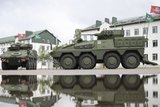Romania tests Spike LR missiles
The Romanian Army has completed testing and evaluation of ten Spike Long Range (LR) missiles as part of its procurement and evaluation process, Rafael Advanced Defense Systems announced on 18 December.
The missiles were fired at the Cincu National Training Centre in Braşov, Romania, in different firing scenarios, including day mode and infrared mode. The firings against tanks and armoured personnel carriers at different ranges saw all ten missiles hit their targets.
The tests involved the infantry launcher configuration of the Integrated Control Launch Unit (ICLU), which is the new modern digital launcher for Spike missiles. The ICLU enables long range target detection capabilities and integration with a tactical network.
The Romanian Army is already using Spike family missiles. This includes deploying the Spike LR missile on a 30mm remote controlled weapon station on the BMP vehicle, and the Spike Extended Range missile (8km) on the Puma helicopter.
Romania's Portable Anti-tank Spike-LR procurement programme will run through 2017-2019 and will equip the infantry, reconnaissance and mountain troop brigades as well as the artillery regiments of the Romanian land forces.
The Spike family consists of missiles suited for land, air and sea platforms, multiple ranges and a variety of targets. The missile features electro-optic CCD or IIR sensors for day/night all-weather operation, as well as a tandem warhead. The missile's lofted trajectories enable the warhead to strike the target at its most vulnerable location with pinpoint precision.
Related Equipment in Defence Insight
More from Land Warfare
-
Germany signs multi-billion-dollar deals for 6x6 CAVS and GDELS Eagle vehicles
The order is a further boost for the Common Armoured Vehicles System programme which has notched notable successes in the past 12 months. The first vehicle, made in Finland, will be delivered next year with local production expected to ramp up in 2027.
-
![Rheinmetall and KNDS tank tie-up narrows trans-European options]()
Rheinmetall and KNDS tank tie-up narrows trans-European options
The French and German governments signed an agreement in June 2018 to cooperate on the development of a new main battle tank under the Main Ground Combat System programme but the effort has struggled. This new agreement may damage it further.
-
![Hungary set to begin using Hero 400 loitering munitions]()
Hungary set to begin using Hero 400 loitering munitions
Developed by Israel's Uvision and with systems being sold in the thousands to multiple European NATO countries and the US, the Hero family of loitering systems is also in production in the US and Italy, the latter through Rheinmetall.
-
![Light Reconnaissance Strike – enabling a vital mission set (Studio)]()
Light Reconnaissance Strike – enabling a vital mission set (Studio)
A new system-of-systems concept will unlock digital integration of sensors and weapons for Light Forces, allowing them to shape the battlefield environment on their own terms and upgrade legacy platforms.























